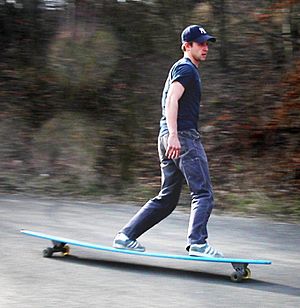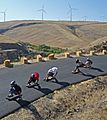Longboarding facts for kids
Longboarding is a fun way to ride a skateboard. It uses a special board called a longboard, which is usually longer than a regular skateboard. Longboards can be anywhere from about 33.5 inches to over 60 inches long!
Longboarding is different from regular skateboarding because it's not mainly about doing tricks or skating on ramps. Instead, longboarders often ride down long, steep hills. They can also use longboards for "cruising," which means just riding around to get from one place to another. Longboards are great for cruising because they are usually faster, more stable, and easier to push than shorter skateboards. You can carry your longboard with you, making it less likely to be stolen than a bicycle.
Contents
What is Longboarding?
Longboarding is a type of skateboarding that focuses on riding longer distances, going downhill, and cruising. It's a popular sport and a fun way to travel. Longboards are designed for speed, stability, and smooth rides.
How is Longboarding Different?
Longboards are built differently from regular skateboards.
- Size: Longboards are, as the name suggests, longer and wider than typical skateboards. This extra size helps with stability.
- Wheels: They usually have larger, softer wheels. These wheels roll more smoothly over bumps and cracks in the road.
- Trucks: The "trucks" (the parts that hold the wheels and let the board turn) on a longboard are designed to turn more freely. This makes it easier to steer and carve.
- Riding Style: While regular skateboards are often used for tricks and skate parks, longboards are better for cruising, downhill riding, and carving.
Ways to Ride a Longboard
There are several cool ways to ride a longboard, especially when going downhill.
Carving
Carving is like skiing or snowboarding down a hill. You turn the board back and forth across the hill. This helps you control your speed and makes the ride more fun. It's a basic skill that helps you slow down on gentle slopes.
Sliding
For really steep hills, longboarders might use a technique called "sliding." This means skidding the board sideways to slow down quickly. It's an advanced move that takes practice. Some riders wear special gloves with plastic pads on the palms. These pads help them balance and brake by letting them touch a hand to the ground while sliding. When learning to slide, it's super important to wear a helmet and full pads to stay safe.
Foot Braking
The easiest way to slow down or stop is by "foot braking." This involves dragging the toe or heel of your back foot on the ground. It's usually the first braking skill you learn when starting out.
Learning to Longboard
Learning to longboard is exciting! Here are some tips to get started:
- Find a Safe Spot: Look for a large, smooth, flat area like a plaza or an empty parking lot.
- Practice Pushing: Start by pushing with one foot, like you're riding a scooter. Get comfortable with balancing.
- Coast and Steer: Once you're moving, bring your pushing foot onto the board. Try to coast and notice how you can steer the board by leaning and shifting your weight.
- Stay Balanced: Keep your body's weight centered over the foot that stays on the board. This helps you go faster and stay stable.
- Push Smart: Push with the ball of your foot and use your arms to help with balance. This can prevent ankle injuries.
- Start Carving: Once you're comfortable cruising, try carving. Lean back and forth to make the board turn and slow down.
While longboards are not mainly for tricks, you can still do some basic ones. Most longboarders enjoy riding down mountains and hills, feeling the wind, and cruising smoothly.
Images for kids
-
Large, grippy wheels and sealed boards often made from weather-resistant material like bamboo make longboarding possible in any season, anywhere, unlike typical skateboards.









